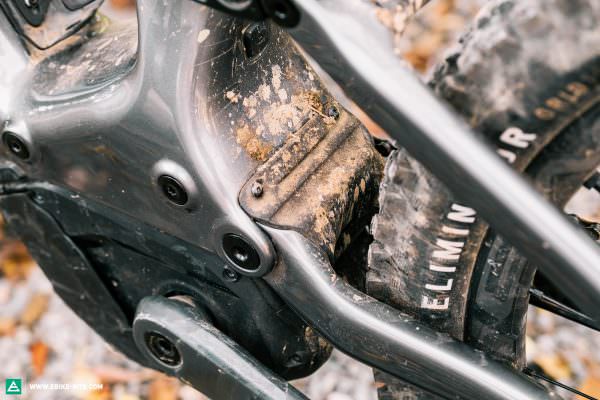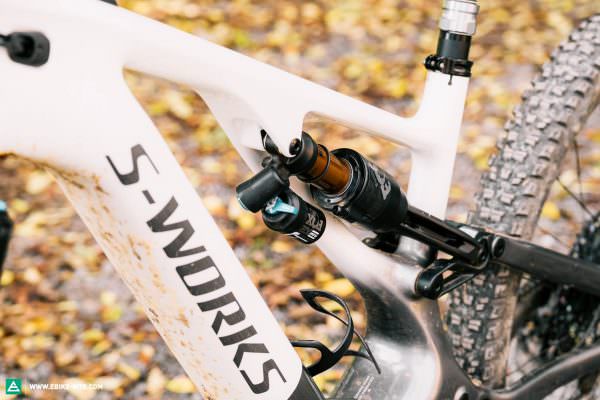With its predecessors claiming the coveted “Best in Test” badge for three years in a row, the brand-new Specialized Levo has some big shoes to fill. Can the latest descendant of the Levo dynasty reclaim its place at the top despite its significantly more progressive concept?
For an overview of the test fleet head to the group test: The best eMTB of 2021 – 25 models in review

22.04 kg in size L (S4) | € 13,999 | Manufacturer’s website
Revolution, not evolution: the new Specialized S-Works Turbo Levo relies on an updated Specialized 2.2 motor and features a redesigned carbon frame, progressive geometry and holistic connectivity solutions. In a separate article, we’ll explain how the new Levo differs from its predecessor. The top tube of the stylish, high-quality frame houses the new smart display, called MasterMind. Here you can see crucial ride data, perform over-the-air updates and tune the support levels of the motor – in conjunction with the Mission Control app the opportunities for customisation are even greater. In typical Specialized fashion, the drive system is seamlessly integrated into the bike, from the speed sensor, charging port and remote through to the SWAT multi-tool integrated into the headset, all the way to the extensive frame protection on the rear end. While no wishes are left unfulfilled, all those smart details and the specially developed digital ecosystem come at a price: the Specialized S-Works Turbo Levo retails for € 13,999.
Optimised for trail performance – The spec of the Specialized S-Works Turbo Levo
The new Specialized S-Works Levo is specced for uncompromised trail performance rather than weight efficiency. The list of components includes FOX Factory suspension with a 38 GRIP2 fork and a FLOAT X2 shock controlling 160/150 mm travel at the front and rear respectively. Shifting is taken care of by a wireless SRAM XX1 Eagle AXS drivetrain which, in combination with the RockShox Reverb AXS dropper, ensures a tidy cockpit. On a negative note, the Shiftmix clamps that Specialized use to connect the shifter and dropper remote to the MAGURA MT7 brakes only have a small range of adjustment, making it hard to position both the brake lever and shifter within easy reach. New for 2021 is the small 27.5″ rear wheel shod with Specialized’s own Eliminator tire, paired with a 29” front wheel and Specialized’s popular Butcher tire. However, both tires come in the puncture-prone GRID Trail casing, which is a risky match for the lightweight Roval Traverse SL carbon wheelset – especially on the rear.

Like most Specialized bikes, the Levo comes with a standard multi-tool integrated into the steerer tube where it’s both silent and easy to reach.

A flip chip in the chainstays allows you to change the geometry of the Levo. Contrary to the labelling, this changes both the bottom bracket height and chainstay length. With special headset cups you can also change the head angle.

The 2.6” tires with GRID Trail carcass are too weak for the sort of speed the Levo can reach. We recommend slightly narrower but more robust tires.

Downhill, the Levo is one of the few quiet bikes in test. With this much damping material, rattling cables and slapping chains don’t stand a chance. Thanks to its internal belt drive, the motor is also very quiet.
Specialized S-Works Turbo Levo
€ 13,999
Specifications
Motor Specialized 2.2 90 Nm
Battery Specialized M3 700 Wh
Display Specialized Mastermind
Fork FOX 38 Factory GRIP2 160 mm
Rear Shock FOX X2 Factory 150 mm
Seatpost RockShox Reverb AXS 100-170 mm
Brakes MAGURA MT7 200/200 mm
Drivetrain SRAM XX1 Eagle AXS 1x12
Stem Deity Copperhead 50 mm
Handlebar Specialized Trail, FACT Carbon 780 mm
Wheelset Roval Traverse SL29 29"/27.5"
Tires Specialized Butcher/Eliminator GRID Trail 2.6"
Technical Data
Size S1–S6
Weight 22.04 kg
Perm. total weight 131 kg
Max. payload (rider/equipment) 109 kg
Trailer approval No
Kickstand mount No
Specific Features
SWAT Multitool

Specialized went to great lengths to protect the bearings, motor and rear end of the Levo against dirt, stray rocks and water. This should increase the longevity and reliability of the frame and motor.

The Specialized 2.2 motor is based on the Brose Drive S Mag with revised hardware and software. Producing 90 Nm of torque, it’s the most powerful motor in the entire test field. Nevertheless, the sophisticated motor setup helps deliver power to the trail very efficiently.

The MasterMind display allows you to customise the data screens to your liking. You can also use additional displays and many additional features from the comprehensive Mission Control app. We’re sure that Specialized will present even more features later this year.
With the new Levo, sizing is rather flexible. The bike is available in a total of 6 sizes from S1 to S6 but thanks to the short seat tubes, you’ll have the choice of at least two, if not three, suitable sizes. With Specialized’s unconventional sizing system, you choose your bike based not on your inseam but the desired handling characteristics: size up for more stability and bike park riding or pick a smaller size if you’re after a more playful character for narrow, technical natural trails. Moreover, you can adjust the geometry of the Levo by using different headset cups and the flip chip in the chainstays. Particularly striking is the steep 76° seat angle, which slackens out only marginally as the dropper extends. On the flats, the rider sits fairly centrally above the motor. However, combined with the low front, the riding position puts too much pressure on the hands during long rides. While the powerful motor and 700 Wh battery provide the perfect foundation for a long-distance tourer, the Levo doesn’t offer the high degree of comfort of the Moustache and SIMPLON – not even with the saddle pushed all the way back.
| Size | S1 | S2 | S3 | S4 | S5 | S6 |
|---|---|---|---|---|---|---|
| Seat tube | 380 mm | 390 mm | 405 mm | 425 mm | 445 mm | 465 mm |
| Head tube | 105 mm | 105 mm | 115 mm | 125 mm | 135 mm | 145 mm |
| Head angle | 64.5° | 64.5° | 64.5° | 64.5° | 64.5° | 64.5° |
| Head angle | 78.0° | 77.2° | 76.7° | 76.2° | 76.2° | 76.2° |
| Chainstays | 442 mm | 442 mm | 442 mm | 442 mm | 442 mm | 442 mm |
| BB Drop | 25 mm | 27 mm | 27 mm | 27 mm | 27 mm | |
| Wheelbase | 1,179 mm | 1,200 mm | 1,225 mm | 1,255 mm | 1,284 mm | 1,318 mm |
| Reach | 412 mm | 432 mm | 452 mm | 477 mm | 502 mm | 532 mm |
| Stack | 605 mm | 617 mm | 626 mm | 635 mm | 644 mm | 653 mm |

Jersey ION Scrub Amp Mesh | Shorts ION Scrub Select
Kneepad ION K-Traze Amp | Shoes Specialized 2FO Roost Clipless
Can the new Levo build on the success of its predecessor? The S-Works Levo on the trail
Roll up to a technical climb and, with its 2.6” tires, the 22.04 kg (size S4) Levo is in its element. The most powerful motor in the entire test field can be intuitively controlled and, together with the excellent traction provided by the suspension, takes the edge off steep climbs on loose, challenging terrain. The new Levo isn’t bothered by fluctuating cadences or the wrong choice of gears, powering resolutely on. When cornering, you’ll have to actively shift your weight forward to keep the front wheel tracking. Not always easy with the Levo begging you to drift or pull a wheelie as you exit the corner – and that’s uphill!
The new Levo is also a pioneer in terms of integration, connectivity, attention to detail and riding behaviour! However, in its latest incarnation, it has evolved from the perfect all-rounder to a mean shredding machine.



Compared to its predecessor, the new Levo is much more capable but also less comfortable on long tours. Instead of the perfect all-rounder, the Levo is one of the fastest and meanest shredders in our 2021 test.
Downhill, the flip chip and resulting change in chainstay length have a huge influence on the handling of the bike and radically transform the character of the Levo: it’s either playful and demanding or smooth and good-natured! Regardless of the setting, the Specialized craves speed. The suspension delivers outstanding performance and generates huge amounts of traction despite the shallow tread of the rear tire. At the same time, it offers sufficient reserves for botched landings and big hits at high speed. Not least because of its low weight and good mid-stroke support, the Levo pulls into the air easily and feels confident on man-made bike park trails, encouraging active riders to play with trail features. On the other hand, it easily gets bored on moderate and flowing trails, where it’s a lot more sedate than the Levo SL. A special quality of Specialized’s bikes: compared to most of the bikes in the test, they’re completely silent downhill!
Tuning tips: experiment with the flip chip and head angle settings | bolt on separate clamps for brakes and shifters amd use more robust tires (e.g. Specialized GRID Gravity casing)

When it comes to connectivity and their app, Specialized are considered pioneers. Just as other manufacturers like Shimano are trying to catch up, Specialized have taken it to the next level with Mastermind!
Riding Characteristics
7Agility
- sluggish
- playful
Stability
- nervous
- stable
Handling
- demanding
- balanced
Riding fun
- boring
- lively
Motor feeling
- digital
- natural
Motor power
- weak
- strong
Value for money
- poor
- top
Conclusion
When it comes to frame details, the drive system, connectivity, build quality, customisation options and the degree of innovation, the new Specialized S-Works Turbo Levo is “next level”, just like its price! On technical climbs and rough descents, hardly any other bike stands a chance against the most powerful eMTB in the test. Unfortunately, this much trail performance comes at the expense of long-distance comfort, which is why the latest-generation Levo can’t reclaim its title as the ultimate all-rounder.
Tops
- high-speed riding performance
- completely silent downhill
- attention to detail
- MasterMind display offers plenty of connectivity and customisation options
Flops
- complex setup with numerous geometry options
- cockpit ergonomics with Shiftmix clamps

You can find out more about at specialized.com
The test field
For an overview of the test fleet head to the group test: The best eMTB of 2021 – 25 models in review
All bikes in this test: Cannondale Moterra Neo Carbon 1 (Click for review) | Canyon Spectral:ON CF 9 (Click for review) | CENTURION No Pogo F3600i (Click for review) | CUBE Stereo Hybrid 140 HPC SLT Nyon (Click for review) | CUBE Stereo Hybrid 160 C:62 SLT Kiox (Click for review) | Ducati TK-01 RR (Click for review) | FLYER Uproc6 9.50 (Click for review) | FOCUS JAM² 6.9 NINE (Click for review) | GIANT Trance X E+ 1 (Click for review) | Haibike AllMtn 7 (Click for review) | KTM Macina Kapoho Prestige (Click for review) | Lapierre Overvolt GLP 2 Team (Click for review) | MERIDA eONE-SIXTY 10K (Click for review) | Mondraker Crafty Carbon XR (Click for review) | Moustache Samedi 29 Trail 8 (Click for review) | ROTWILD R.X375 ULTRA (Click for review) | Santa Cruz Bullit X01 RSV Air (Click for review) | SCOTT Ransom eRIDE 910 (Click for review) | SIMPLON Rapcon PMAX (Click for review) | Specialized S-Works Turbo Levo (Click for review) | Specialized S-Works Turbo Levo SL (Click for review) | STEVENS E-Inception AM 9.7 GTF (Click for review) | Thömus Lightrider E2 Pro (Click for review) | Trek Rail 9.9 X01 (Click for review) | Whyte E-150 RS 29ER V1 (Click for review)

Relaxed and comfortable riding on surfaced roads, both uphill and downhill.↩
Easy climbs up trails with few obstacles, wide turns and a moderate incline.↩
Active and playful descents on easy trails with few obstacles, wide turns and a moderate slope.↩
Single-track climbs on challenging terrain. Loose ground, steps, roots, tight corners and occasionally extreme inclines.↩
Singletrack descents on challenging terrain. Loose ground, steps, roots, tight corners and small jumps as well as some very steep descents.↩
High speed descents on sometimes very rough trails with large jumps and obstacles that you can’t roll over.↩
The rating used for riding characteristics refers to the bikes in the group test and the current state of development of eMTBs. The best bikes managed to blend supposedly opposite riding characteristics, feeling both lively and stable at the same time. The handling describes the balance of the bike on downhill sections. The information regarding motor-power refers to the ride-feeling in the overall context of the bike and not exclusively to the motor – that’s why the same motor can present different values.↩
Did you enjoy this article? If so, we would be stoked if you decide to support us with a monthly contribution. By becoming a supporter of E-MOUNTAINBIKE, you will help secure a sustainable future for high-quality cycling journalism. Click here to learn more.
Words: Photos: Various









